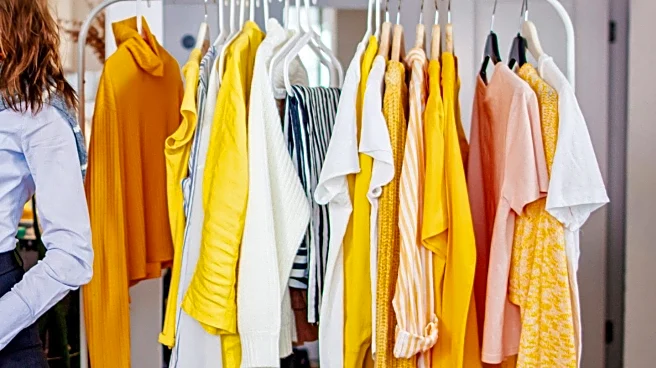What's Happening?
Cos, a high street label under the H&M group, took center stage at New York Fashion Week with a brutalist-themed collection. The event was held in a former rope factory in Brooklyn, featuring a concrete-effect catwalk and steel benches. The collection included oversized coats in cashmere and leather, cinched with skinny belts, and trousers paired with leather shoes. The appearance of Cos alongside heritage brands like Ralph Lauren and Coach signifies a shift in high street fashion towards more luxurious offerings. This move is part of a broader trend where high street brands collaborate with designers and celebrities to enhance their appeal. Cos's catwalk pieces are priced higher than its main collection but remain more affordable than designer brands.
Why It's Important?
The participation of Cos in New York Fashion Week highlights the growing pressure on high street brands to differentiate themselves amid economic challenges such as the cost-of-living crisis and high-street closures. By adopting a 'luxe-washing' strategy, these brands aim to capture customer loyalty in a market increasingly divided between fast fashion and high-end luxury. Collaborations with designers and celebrities are part of this strategy, offering consumers a taste of luxury at more accessible prices. This shift could redefine consumer expectations and purchasing behaviors, impacting both the fashion industry and retail markets.
What's Next?
Cos's approach may prompt other high street brands to follow suit, potentially leading to more collaborations and high-profile fashion events. As brands strive to maintain authenticity, they must balance luxury appeal with genuine consumer engagement. The success of this strategy could influence future fashion trends and retail strategies, as brands navigate the complexities of consumer loyalty and market stratification.
Beyond the Headlines
The trend of high street brands moving towards luxury could have ethical implications, particularly concerning sustainability. While luxury perception often involves higher prices and limited availability, the use of synthetic fabrics in high street collections raises questions about environmental impact. Brands must consider these factors to maintain consumer trust and align with growing demands for sustainable fashion.










